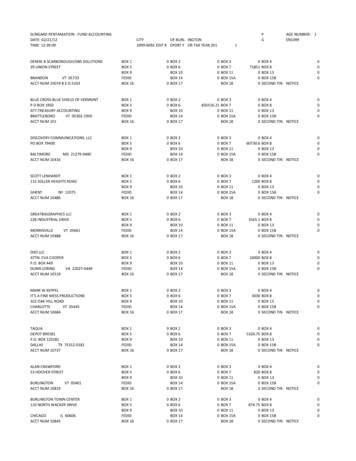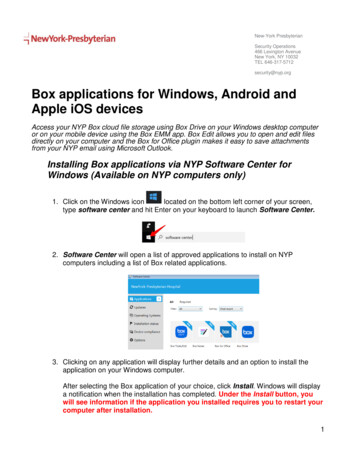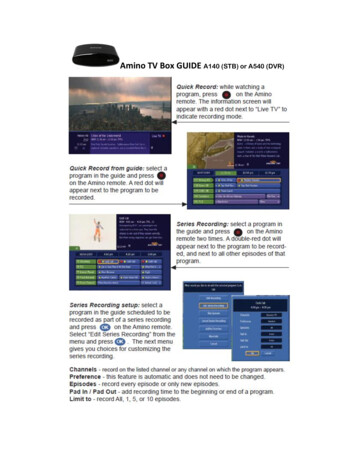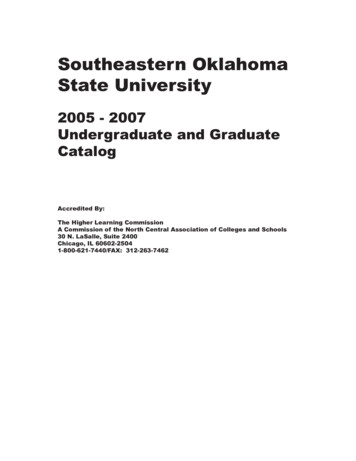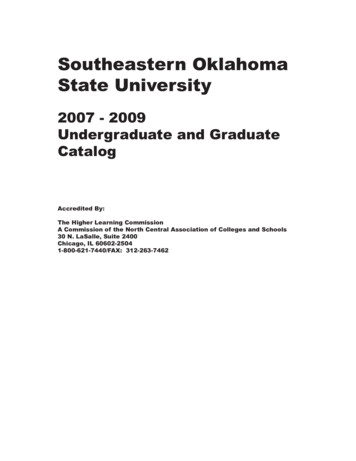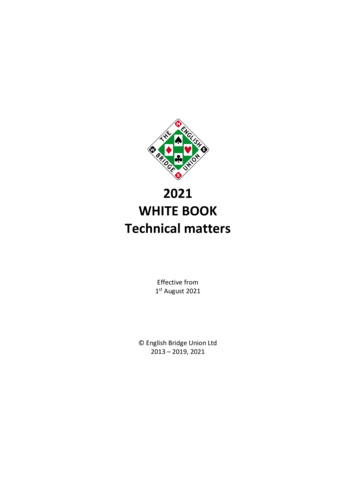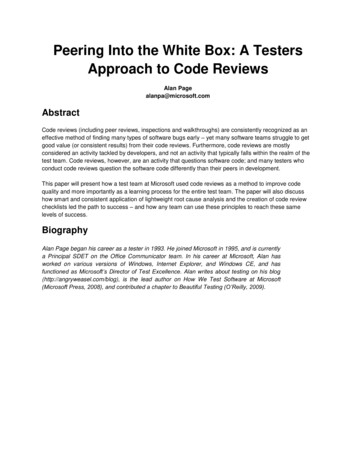
Transcription
Peering Into the White Box: A TestersApproach to Code ReviewsAlan Pagealanpa@microsoft.comAbstractCode reviews (including peer reviews, inspections and walkthroughs) are consistently recognized as aneffective method of finding many types of software bugs early – yet many software teams struggle to getgood value (or consistent results) from their code reviews. Furthermore, code reviews are mostlyconsidered an activity tackled by developers, and not an activity that typically falls within the realm of thetest team. Code reviews, however, are an activity that questions software code; and many testers whoconduct code reviews question the software code differently than their peers in development.This paper will present how a test team at Microsoft used code reviews as a method to improve codequality and more importantly as a learning process for the entire test team. The paper will also discusshow smart and consistent application of lightweight root cause analysis and the creation of code reviewchecklists led the path to success – and how any team can use these principles to reach these samelevels of success.BiographyAlan Page began his career as a tester in 1993. He joined Microsoft in 1995, and is currentlya Principal SDET on the Office Communicator team. In his career at Microsoft, Alan hasworked on various versions of Windows, Internet Explorer, and Windows CE, and hasfunctioned as Microsoft’s Director of Test Excellence. Alan writes about testing on his blog(http://angryweasel.com/blog), is the lead author on How We Test Software at Microsoft(Microsoft Press, 2008), and contributed a chapter to Beautiful Testing (O’Reilly, 2009).
1.IntroductionCode reviews - the practice of systematically examining software source code - has been a long usedpractice in software development. Code reviews are one of the first lines of defense to find errors and area “cheap” way to find bugs because of this. A second pair of eyes on anything is often one of the moststraightforward ways to find an error. In my experience, code quality often improves if the author merelyknows the code will be reviewed, as the author is less likely to write “tricky” code or take shortcuts.Code reviews have a learning aspect as well. They work well for sharing techniques or algorithms, andare a great way to integrate new people onto the team or help team members learn about other parts ofthe project.Finally, code reviews help a team build trust. Teams that conduct code reviews get used to the idea ofanalyzing the code, and not the person; and they get used to their code being critiqued and notthemselves, and this gives them trust and freedom to talk about other things to improve in the productwithout making it a people issue.2.The Tester Point of ViewCode reviews are most often recognized as an activity done by the development team before checking incode or before passing it off in executable form to the test team. Developer code reviews are one of thefarthest upstream activities there are to find bugs, thus are one of the most cost-effective methods offinding bugs.Testing - even in the most agile of development environments, most often occur downstream from wheredeveloper code reviews happen. One notable exception is to pair a developer and a tester in a pairprogramming session. Pair-programming is, in fact, a form of code review.So why have testers perform code reviews?On the Office Communicator team at Microsoft, our reasoning is this: our developers (and hopefully yourstoo) write unit tests. Unit tests are another upstream method of finding errors early and do a lot to improvecode quality. However, we still test the code - on a much larger scale than unit tests are designed to do,but our approach to testing from the test team perspective is different from the developer approach towriting unit tests. Many unit tests, as good as they are at finding errors, test little more than the happypath. Unit tests test the code from the developer’s point of view and try to prove that the design andbehavior is correct. Testers, on the other hand, ask numerous questions about the software they’retesting. Many of these questions begin with “what if?” – as in “what if we tried a really long string in thisedit field?”, or “what if I try to launch the application twelve times?”. Most of these questions are wellbeyond the scope of what a unit test should do, and is one of the reasons we have software testers.We apply the same reasoning to code reviews. When developers review code, they don’t ask as manyquestions. They make sure variable initialization is correct, that algorithms are optimal, and that the codestructure and flow makes sense. The effort of review is worth it. On our team, many of the developer codereviews of significance (more than a few dozen lines) finds at least one issue or suggestion during review.We also hypothesize that testers will ask different questions of the code than developers. When reviewingcode, instead of asking questions like “will this code work correctly?” testers are more prone to askquestions like “under what situations that I can think of will this code fail?” The tester code reviews werenot designed under any means to replace the developer reviews already in place, but were designed as
just another test technique for the test team. With this in mind, we set out on our experiment of testercode reviews.3.Types of Code ReviewsCode reviews vary in style, formality, and effectiveness. The least formal type of review is where theauthor of the code literally grabs someone out of the hall and says, “Hey – would you take a look at this?”A step up from there (in both formality and effectiveness) is to send an email or instant message toteammates asking for a quick review. At the other end of the spectrum are formal code inspections wherepre-work for each reviewer is identified, and a moderator ensures that the code is reviewed, and statisticsare tracked carefully in a group meeting.Microsoft development teams use varying degrees of formality in code reviews – typically fallingsomewhere between the extremes outlined above. Code reviews are a good practice for developmentteams and their value to product quality is significant.iCode inspections as invented by Michael Fagan are the most formal method of code review, and arehighly effective at finding errors in code early in the product development cycle. However, they requirethat developers spend a large amount of their time preparing for, and attending the inspection meetings(also in training to know how to do a Fagan inspection in the first place). In many organizations practicingFagan inspections, the number of total person-hours required for reviews will outweigh the coding time.This is, in my experience, the primary reason more teams do not attempt Fagan inspections.4.Our Approach to Tester Code ReviewsFor our tester code reviews, we decided to try a slightly less formal approach. We wanted the reviews tobe as thorough as possible while keeping time investment as low as possible and interest andengagement of the team high.4.1 The KickoffWe began the effort by presenting a tech talk for the test team on code reviews. Since most of the teamwas only familiar with ad-hoc code reviews, we presented an overview of different code reviewapproaches and techniques in order to provide some background information.A week later, we held another kickoff meeting for all testers on the team who were interested in takingpart in this code review experiment. We did not look for any specific characteristics or skills in theparticipants other than a willingness to try something new and commit a small amount of time every weekto the effort (note that nearly all testers at Microsoft are fluent programmers). In this meeting, we wentover the details of our code review process and expectations for the volunteers. The expectations definedat the beginning of the experiment included: Review for 60-90 minutes each day, and record the time spent on review. Part of thelearning process for doing good code reviews is practice. By establishing a rhythm of performingreviews, we expect testers to improve their technique. However, we’ve also found that the abilityto find errors consistently in code declines after 60-90 minutes, and we also wanted eachparticipant to discover when their own reviewing abilities started to fade within a session. Finally,we asked them to track the actual time so we could calculate yield – the number of issues theyfound within their review period.
Make a note of all issues or questions found during the review. We used this information inthe review meeting, as well as for tracking yield.Schedule a regular meeting for team reviews. We asked teams to schedule a regular meetingwhere they would discuss and note errors or questions found during the individual reviews. Wehad two primary reasons for the regular meetings. The first was to determine which issuesmultiple members of the team are finding, as these had a higher likelihood for being real errorsthat are likely to be fixed. The second, and equally as valuable was the learning aspect. Thedifferences in issues found by different team members lead to discussion and sharing of how aparticular reviewer discovers an error, which in turn leads to improvement by all reviewers insubsequent reviews.Use a checklist. We gave everyone a checklist including types of errors generally found duringcode review. We asked them to select one item on the checklist, and review a section of codelooking only for that single item. (A “section” could be a single function, a class, a screen, or anyother sensible partition). Looking for a single item enables a reviewer to minimize distractions andfind errors more consistently. Reviewers would then have the option of either reviewing anadditional section of code looking for the same class of error, or could review the same sectionagain looking for a different error. A sample checklist is included in the appendix.At the end of the kickoff meeting, we divided the attendees into teams (mostly representing particularfeature areas) and gave each team the initial assignment of selecting the code for their first review.4.2 Selecting the Code for ReviewWe did not have a goal of reviewing all code. Given the size of our product and the other testinginvestments we have, this was not feasible or practical. Instead, we used other factors to guide us in thisdecision.We used a risk-based approach to identify potential code for review. Some of the areas we looked at toidentify risk included: 5.Code Churn – We identified areas of the product with high amounts of recently modified oradded code and selected source files within that area as potentially reviewable.Code Complexity – Code with a large number of paths or variables, or code with a high numberof dependencies is prone to error.Tester Intuition – “Gut feel” or “tester intuition”; testers often have a hunch of where bugs maylurk, and in our experience, these hunches are accurate enough to influence the selection.Tester Code Reviews in ActionDuring each meeting, we began by noting how much time each reviewer was able to review the code.Next, we walked sequentially through the code assignment for the week, stopping to discuss each issuenoted by the reviewers. These discussions included bugs as well as areas of confusion (e.g. details of the.Net common language runtime garbage collector). The result of much of the initial effort was in learningthe product, or some of the idiosyncrasies of the programming languages (our product uses both C andC#).Most teams averaged about one thousand lines of reviewed code each week. The initial stages includeda lot of learning time as the reviewers got used to the idea of reviewing the code and using the checklist.We also encouraged everyone to suggest new checklist items if they found additional errors, and to
suggest removing checklist items that were not (or did not seem) effective at finding errors. We were nottrying to find every single possible error, and keeping the number of checklist items manageable wasimportant.Testers found, on average, ten unique “issues” per thousand lines of code during review. Slightly lessthan ten per cent of these were bugs that could affect the customer experience of the product. Theremainder of the issues were code issues potentially affecting maintenance and readability of the code.The intangible value of a maintainable code base is important enough, that over eighty-five per cent ofthese issues are scheduled to be addressed.6.Lessons LearnedTest team code reviews remain in progress on our team, and we continue to tweak our approach as welearn what works and what does not work. Thus far, test team members as well as product managementview the approach as successful, and as something that should continue throughout this release and intothe next release of our product.Some of the biggest lessons learned include: Learning – Initially, much of the code review effort went toward learning the product. The testerswere adept in the functionality of the product, but reviewing the code opened up many of thenuances of the implementation. Although we didn’t find many bugs in the initial steps, we felt thatlearning the how and why of the code implementation was a benefit for the team. Several of thetesters on the team found additional areas or parameters to test based on the code review.Balancing the code review commitment with “other” test activities – we also discovered thatit was difficult for many of the reviewers to commit regularly to the 60-90 minutes of review perday. Each of the testers involved in the review was also responsible for their day-to-day testingwork, and this “new” effort sometimes fell by the wayside.Involving the development team – we started the process attempting to have as littledevelopment effort as possible, but we changed that approach slightly. Originally, the test teamperformed the reviews, and then one representative from test took the results to the developerand met one on one to discuss the issues and questions. We ended up modifying that and invitedthe developers to attend the review meetings. This enabled us to transfer knowledge betweentest and development faster, and increased the ability of testers to read the code.Developing specialization and experts – reviewing code is a lot different from most other testtechniques, so we did not expect everyone to become an expert. Over time, testers tend tospecialize, and we expected that there would be differentiation in tester’s ability to review codeeffectively. In the relatively short time, we’ve asked testers to review code we’ve seen three of theparticipants stand out as effective code reviewers. We expect that, as we continue with this effort,that a few more stars will rise.The checklist approach – the formality of the approach worked well for the team. The use ofchecklists and the inspection meeting encouraged learning and participation, without adding toomany extra meetings. Our goal was to keep the approach as simple and lightweight as possiblewithin a small level of formality (e.g. checklist driven inspections, regular meetings, and a fewmetrics).Bug tracking – we remain excited about the learning opportunities that these reviews created,but another potential drawback of our current approach is that we do not track the bugs foundduring code review in our product bug tracking system. We did this purposely to keep the systemlightweight, but by doing that we lose a bit of insight that we can share with future testers and
developers on the team about how the code works and what types and numbers of bugs havebeen found in a particular component over time from reviews.7.RecommendationsCode reviews performed by testers have been successful on our team, and we expect that the practicewill work well for any team with some obvious precursors. The need for source code access is obvious,but a level of trust between the testers and developers on the team is also necessary in order to besuccessful. Testers need to know that their feedback will be taken seriously, and developers need tounderstand that the critique is of the code, and not a critique of the developer. The testers will also needenough programming language background to be effective in reviewing the code.8.Future PlansWe expect to continue the practice of test reviews for the long term. It has enabled our test team to findbugs in a new way and has facilitated learning across the team. In addition, we’ll ask our “star” reviewersto examine much of the code introduced late in the product cycle to reduce the risk of regression or newbugs from those late changes. We’ll also continue to encourage and coach teams in reviewing code sothat we can continue to grow new review experts and increase the quality of our product code overall.We will also examine how we can tie the comments and feedback from the reviews to the actual code.We expect that this will make learning the code much easier for new team members, and since we’re onlylooking at code that we deem to be risky in the first place, chances are that any additional context we canprovide with the code will be beneficial for anyone involved in developing or testing that code.9.Recommended ReadingSoftware Inspection – Tom Gilb & Dorothy Graham. Addison-Wesley Professional (January 10, 1994)The Best Kept Secrets of Peer Code Review - hpSoftware Inspection (web article) - http://www.the-software-experts.de/e dta-sw-test-inspection.htmFagan Inspections (Wikipedia entry) - http://en.wikipedia.org/wiki/Fagan inspection
AppendixSample checklist items iAre input parameters validated and checked for null?All exceptions must not be caught and sunk (i.e. not rethrown)Do the comments accurately describe the code?Examine loops for performance issuesThere must be no hard-coded strings and magic numbers in the codeAll user-visible strings must be localizable (i.e. retrieved from a resource file)Verify correctness of operatorsIs arithmetic safe for overflow and 64-bit math?Are the functions or source files exceptionally large or complex?Are COM interfaces properly ref counted?If there are multiple exit points (returns) from a function, can they be combined?Is the code overly complex? Could it be simpler?Do the function and variable names make sense?All memory allocations should be checked for failureAre shared resources guarded appropriately using synch objects?Are threads cleaned up on exit?Check for precedence errors – parenthesis are freeAre untrusted inputs validated?Check for properly constructed switch statementsAre comments appropriate and useful?Does the code have performance implications – if so, are optimizations possible?Are there spelling errors in names or comments?Have boundary conditions been checked?Are there unused elements in data structures?Are string buffers big enough for localized content?Does the new code duplicate code that exists elsewhere in the project?Are there unnecessary global variables?http://en.wikipedia.org/wiki/Fagan inspection
Testing - even in the most agile of development environments, most often occur downstream from where developer code reviews happen. One notable exception is to pair a developer and a tester in a pair-programming session. Pair-programming is, in fact, a form of code review. So why have testers perform code reviews?




